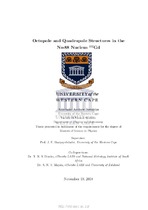| dc.contributor.advisor | Sharpey-Schafer, John | |
| dc.contributor.author | Netshiya, Adivhaho Andrew | |
| dc.date.accessioned | 2019-02-12T09:19:35Z | |
| dc.date.available | 2019-02-12T09:19:35Z | |
| dc.date.issued | 2018 | |
| dc.identifier.uri | http://hdl.handle.net/11394/6577 | |
| dc.description | >Magister Scientiae - MSc | en_US |
| dc.description.abstract | The focus for this work is on 152Gd produced by the 150Sm( , 2n)152Gd reaction at
a beam energy of 25 MeV. The nucleus has been previously studied for both low spin
states and high spin states at di erent energies. The most recent work on 152Gd
was done by S. P. Bvumbi using the 152Sm( , 4n)152Gd reaction at a beam energy
of 45 MeV where she was able to populate low spin states and assign spins and parities
to the levels as shown in Fig. 1.1.
The nucleus 152Gd, with proton number Z=64 subshell closure, belongs to a set of
isotones having N=88 in the transitional region with just 6 neutrons outside the N=82
closed shell and lies just before the N=90 permanently deformed region. The isotope
152Gd is in the transitional region, consequently its nuclear collective motion will quickly
evolve from vibrational to rotational motion. The low lying K =0+2
bands in N=88
and 90 nuclei appear at low excitation energies and are poorly understood.
Key to these studies is the crucial question about the legitimacy of the low lying K =0+2
bands being described as vibrations along the symmetry axis. The current work
examines the K =0+2
band with the objective of providing more understanding. Previous
studies of N=88 isotones saw consistent E1 transitions both from and to the K =0+2
bands and octupole bands, namely 144Ba, 146Ce, 148Nd, 150Sm and
154Dy nuclei. The experimental systematics of the low lying negative parity
states in N=88 isotones are remarkably well reproduced by theoretical calculations of
the quadrupole octupole coupling (QOC) modelas shown in Fig. 1.2. | en_US |
| dc.language.iso | en | en_US |
| dc.publisher | University of the Western Cape | en_US |
| dc.subject | Beam energy | en_US |
| dc.subject | High spin | en_US |
| dc.subject | Low spin | en_US |
| dc.subject | Energies | en_US |
| dc.subject | Nucleus | en_US |
| dc.title | Octupole and quadrupole structures in the N=88 nucleus 152Gd | en_US |
| dc.rights.holder | University of the Western Cape | en_US |

